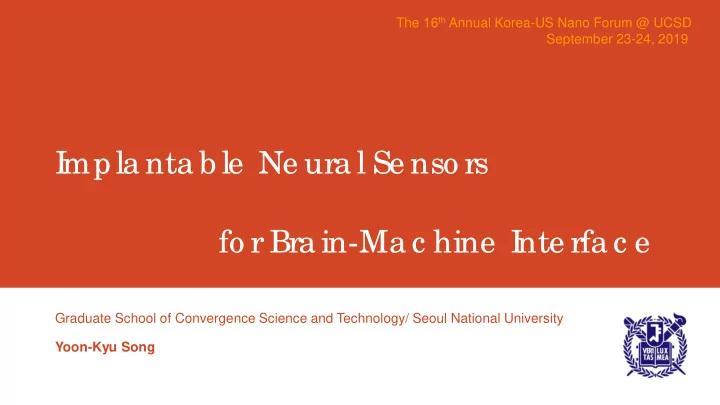

The 16 th Annual Korea-US Nano Forum @ UCSD September 23-24, 2019 I mpla nta b le Ne ura l Se nso rs fo r Bra in-Ma c hine I nte rfa c e Graduate School of Convergence Science and Technology/ Seoul National University Yoon-Kyu Song
Introduction Brain Computer Interfaces in Neural Engineering Point of View Augmenting Functio ional A l Abilit ilitie ies o of Human Ghost in the Shell (2017) We may not be heading the direction in the movies, but they show endless possibilities thr hroug ugh i h imagination
Introduction Maybe not only through imagination, but also through sc scientific a and nd t techno hnological a advanc ncement nts Hochberg et al, Nature (2012) Schwartz et al, Lancet (2012) Possibilities of augmenting human (motor) functions have been shown in prosthetic devices for the people with disabilities – any issue with the present devices/BCI hardware?
Wireless Neural Sensors Full spectrum electrophysiology recordings during free behavior (in non-human primates, currently transition to human patients) Yin et al, Neuron (2014)
Fully Implantable Neural Sensors BACK FRONT Digital controller IC ADC BIC Sensor Receiving Coil VCSEL (IR laser) 1cm Song et al, IEEE TNSRE (2009)
Fully Implantable Neural Sensors Mestais et al, IEEE TNSRE (2014)
Centralized vs. Distributed Neural Sensors Centralized neural sensors (conventional approach) - Developed through well-established medical implant platform (pacemaker, DBS, etc.) - Relatively loose power requirement due to availability of high-power delivery schemes - Encapsulation options: highly reliable Titanium hermetic sealing available - Fully implantable system without external radio (at least no head-mount interface) - Issues with Scala labilit ility a and Fle lexib ibilit lity
Centralized vs. Distributed Neural Sensors Distributed neural sensors (high risk and “hopefully” high return approach) - Developed on the basis of system on chip (SoC) technology - Scala lable le multi-channel network implemented via RF communication protocols - Physically uncorrelated/non-regular individual channels enable hig ighly ly f fle lexib ible implementation - Extremely tight power requirement (depending on the size) - Limited encapsulation options (polymer, ceramic) - Requires external units (e.g. head-mount radio transceiver)
Design Features of “Neurograins” – 1.5 Years of Prelim Work Sub ubmillimeter s sens nsor/ r/stim no nodes: Neuro rogra rains ns Distributed system (currently epicortical) Very large number of nodes: 1,000 ~ 10,000 Wireless power and telemetry Networking Adaptive selection from sub-population of sensors Plan for further scaling and miniaturization of intracortical implantable neurograins
System Level Overview
Neurograin Microelectronics – Ultra Low Power, Ultra Compac t General Architecture of Neurograin SoC (Sensor)
Neurograin Microelectronics (in Collaboration with UCSD)
Wireless Power and T elemetry
Packaging and Encapsulation
RF T elecommunication (in Collaboration with Brown/Qualcomm)
High Throughput Implantation
Summary of Current Neurograin System Developed first generation of sub-mm microelectronic chiplets for wireless recording and stimulation Validated IC performance at benchtop Developed and validated hermetic packaging approaches for microscale implants Developed RF telecom approaches and implementation on portable platform Explored high throughput implantation techniques for future generations of intracortical implantable neurograins Plan for further scaling and miniaturization of intracortical implantable neurograins
Thank you for your attention! Collaborations: Brown University (Nurmikko, Larson), UCSD (Aspeck, Mercier, Leung) Acknowledgements: J. Jang, C. Lee (SNU), J. Lee, J. Jeong, F. Laiwalla (Brown) Support: NRF (Brain Research Program/Basic Research Program)
Recommend
More recommend